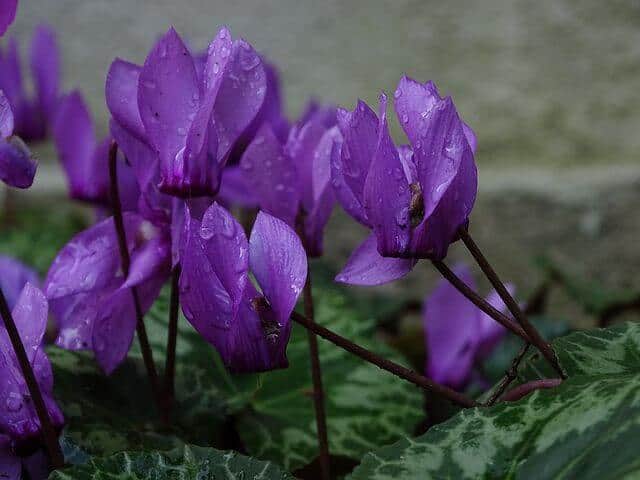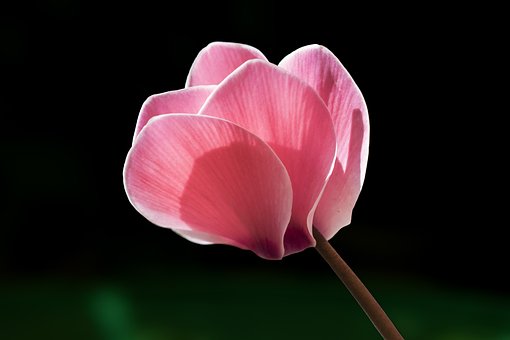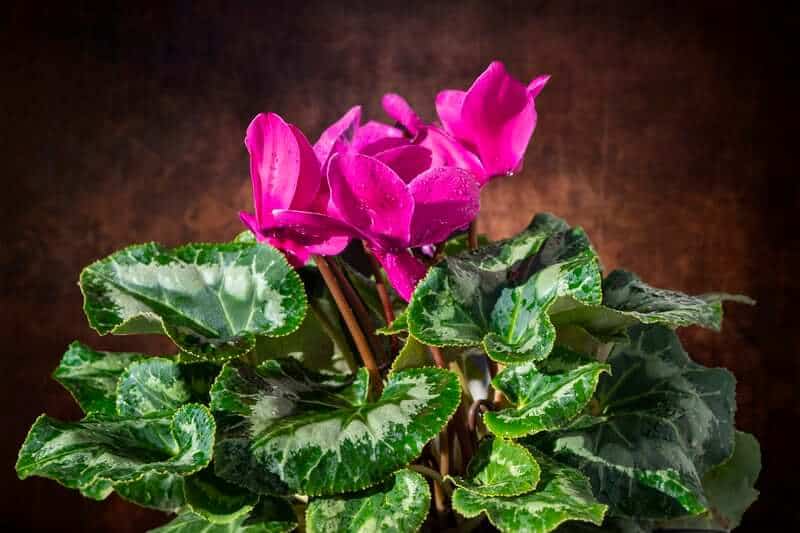Last Updated on September 9, 2023 by a Friendly Gardener
A Mediterranean native, the Cyclamen belongs to the Primulaceae family. Botanically named the cyclamen persicum, it is generally referred to as just cyclamen. Cultivated primarily as a houseplant, it will do well outdoors if the environmental conditions are correct.
Cyclamens, in many colors, are very popular at Christmas as gifts. This perennial flowering plant is characterized by its fleshy tuberous roots. During its dormancy period in the summer, it will die back to regenerate in autumn.
Cyclamen blooms are found in pink, white, purple, and red. Deep green heart-shaped foliage variegated with silvery marbling patterns frame blooms. These plants are most commonly sold in garden centers, nurseries, and supermarkets. Inspired gardening enthusiasts may choose to grow them from seed.
Cyclamen Care

The cyclamen is most often cultivated in containers. It is a vividly colored specimen that will brighten dreary winter months with a splash of color. After sleeping in the summer dormancy, it regenerates and blooms in the fall.
Summer temperatures cause the cyclamen to enter dormancy. In cooler, shadier environments, plants will nap but not enter dormancy entirely. It will however lose blooms and thin out only to flower again in the fall.
To encourage future blooming, cut spent blooms at the plant’s base. As soon as flowering slows, you‘ll know it’s about to enter dormancy. Allow your cyclamen to dry out for roughly three months. If the roots receive too much water during the dormant period, it may result in rotting. Give your plant a taste of water but limit the amount.
Soil
Cyclamen prefers rich organic soil that drains well. The soil pH needs to be a bit acidic at 5.8 more or less. For container growing, standard potting soil mix with some sphagnum peat blended is ideal.
Light

Cyclamens love indirect bright light during the winter months. Winter is the plant’s growing period. In the summer months, position cyclamens in cooler, darker locations with good air circulation.
Water and Humidity
When foliage is present, your plant is still growing and needs to be watered whenever the soil feels dry to about an inch deep. Avoid wetting leaves and the plant’s crown which can lead to rotting.
As soon as the plant loses most of its foliage, water occasionally prevents the soil from drying out.
Water on foliage can cause mildew, so consider placing your plant in a water-filled saucer to absorb necessary water for about an hour.
Cyclamens love high humidity during their growing period. If you are cultivating yours indoors, use a pebble and water tray or a space humidifier. Fill a tray with pebbles and water. Place your plant on top of the tray but above the water to prevent root rot. You can also place a small water-filled recipient in the vicinity of the plant.
Temperature
Despite being Mediterranean natives, these plants do not like heat. They fare better in temperatures from 60° to 70° Fahrenheit in the day and 40° to 50° F. at night. Do not expose your plants to frosts.
Indoors, your cyclamen needs a bright cool spot. Avoid direct sunlight exposure. When temperatures are too hot, the foliage will turn yellow, and the cyclamen will go dormant.
If moving a potted cyclamen outdoors in summer, they will need to be returned indoors before the temperatures drop. Move plants indoors while windows can still be left open.
Fertilization

Feed your cyclamen every two weeks when they are in full leaf in the growing season. Do not fertilize during summer dormancy. A diluted liquid fertilizer low in nitrogen is perfect.
Pruning
Cyclamens do not need to be pruned. Spent leaves and flowers can be snipped at the stem base.
Repotting
It’s best to repot a cyclamen every two years. Select a new pot with an inch of extra space around the plant’s tuber. Allow the tuber to peek out of the soil bed. Cyclamens can be repotted during dormancy.
Remove the tuber from its pot and gently remove old soil. Position it in a new container with fresh soil. The plant’s top should be positioned about two inches from the pot’s rim. Cover with potting soil and locate it in a shady spot. In early September begin watering. New growth will appear soon after.
Cyclamen Propagation

Cyclamens can be propagated through plant division. Leaves and stem cuttings are not a viable option. In autumn, take the tuber root from the soil and divide it. Replant the tuber sections under two inches of soil. Do so in the fall because you want root development before the winter arrives. Add a layer of mulch as protection from cold weather if dividing and cultivating plants outdoors.
Cyclamen can also be propagated from seeds. Germination is lengthy. Soak seeds in water for 24 hours, and place in the soil. When seeding outdoors, do so in the spring when soil beds measure between 45° and 55° Fahrenheit. Your new cyclamens will flower the following year.
Cyclamen Toxicity
The cyclamen is toxic for both pets and humans. The ASPCA indicates dogs, cats, and horses. Also, take care to place it out of the reach of small children. Poisoning symptoms can include:
- drooling
- loss of appetite
- vomiting
- diarrhea
Severe cyclamen poisoning can result in an abnormal heart rate and seizures. It can be fatal. If you suspect cyclamen ingestion, contact your doctor, veterinarian, local poisoning center, or emergency room immediately.
Pests, Diseases, and Problems
Common Cyclamen cultivation problems may include:
· Cyclamen Collapse
Cyclamens typically collapse from overwatering. Mushy and brown-colored centers indicate root rot or crown rot from water dousing the stems and leaves. Collapsing can also be caused by very low environmental temperatures, or vine weevil larvae have infested the plant’s roots.
· Yellowing Foliage
If leaves are yellow in the fall or winter, the environmental temperature is too warm. Yellowing foliage can also indicate overwatering and underwatering. Water your plant when the soil bed appears dry. In the spring, yellow leaves are normal because the plant is dying back before dormancy.
Common in humid conditions, a fuzzy grey mold appears on the flowers or the plant’s stems. Remove spent flowers and dead foliage promptly. Avoid splashing water on the foliage.
-
Poor blooming
This generally happens when the environment is too warm causing the plant to enter early dormancy.
Pests that can disturb cyclamens include aphids, vine weevils, cyclamen mites, spider mites, leaf miners, and thrips.
A Final Consideration

Cyclamen plants are spectacular winter flowering plants known for their vividly colored blooms in many varied hues. Flowers can be scented or feature frilly edges with lush heart-shaped marbled deep green foliage.
With proper care, they can bloom for more than six weeks. These winter flowers brighten homes, places of business, shops, and offices yearly. They can be a beautiful addition to outdoor gardens in the right climate, and they are not invasive. They will not disturb other vegetation in your garden.
Consider giving a cyclamen plant during the holidays. It will be lasting to a flower arrangement or bouquet.

